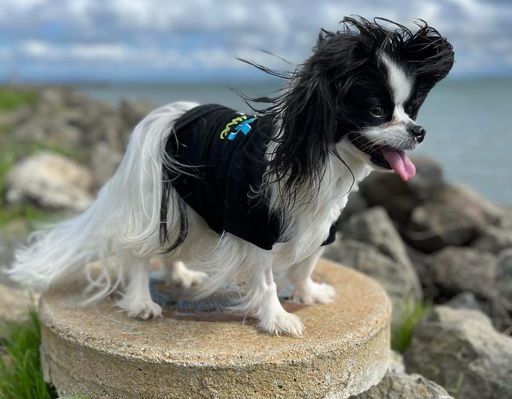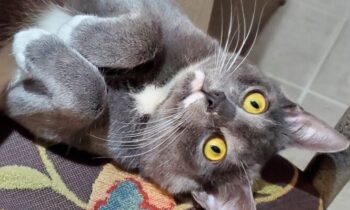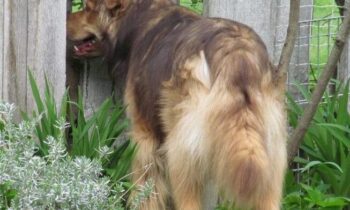

I stopped scrolling immediately that morning when I saw the post on Facebook—a small dog belonging to a friend had just been attacked by a bigger dog. I read on to get details and checked back almost hourly, expecting more bad news. It was a horrifying situation and I was frightened for the dog.
As the day went on, the posts continued. Later, when the information turned more positive, I decided to ask if my friend would share the story in an article here, in her own words. She agreed.
Alisha Ardiana (California) The density of San Francisco is really tough on dogs. It’s very difficult to find a place to walk without interruption by people and other dogs. I’m extremely lucky that we have a bird preserve called Heron’s Head Park. I’ve spent many years working there. I walk reactive dogs for a living, and it’s very normal for me to go there three times a day.
When I work with a new client, we do a 90-minute Zoom consult so we can chat about their situation without them worrying about their dog. They get homework and videos to review. We then meet in person, usually one to two weeks later. I like meeting them at this park because it smells amazing for the dogs. It has fantastic sight lines so I can easily anticipate if anything is approaching. And it gives me a very good picture of what the dog is sensitive to.
When the pandemic hit, like most trainers, I scrambled to do online training. But I felt like something was severely lacking. I hired Ian Carr and we’ve spent about a year together making videos. He redesigned my website and the majority of the videos we made are featured there. One video in particular is paid content for my clients called “Gamify Your Walks.” It explains why we use games to help our dogs develop coping strategies in public. I started realizing that when client dogs knew the games, it made it easier for them to coexist with my dog. That’s what began my journey of Gamify Your Group Walks in the fall of 2021.
Once a month, I invite clients to join me on a walk at Heron’s Head.
Anyone who comes on the walk has done the 90-minute Zoom consult with me, they have received homework and videos, and then we have done an individual training session at the bird preserve. I break the walk into two groups, Bigs and Littles. (I have flirted in the past with mixing the groups, and now am so grateful that I do not do that.)
We follow the same formula as their original walks there, which gives the dogs predictability. There have been some tense moments, but it has been a wonderful resource for my clients and something that I enjoy monthly.
Unfortunately, because of the recent rainy season, I’ve had to cancel many of these walks. The day of this particular walk, March 4, I was texting with the clients at 8:30 a.m., discussing if we should go through with it. Based on the forecast, we all agreed it would be okay. (If there had been a downpour forecast, which is actually what happened, I would’ve canceled the walk. I also had a sore throat. I debated canceling for the sore throat, which is not COVID, but, again, because I’ve had to cancel three walks in the past, I pushed through.)

Photo by Alisha Ardiana
9:00 AM
The first walk went well. There is a terrier that my dog does not like, but they did great on the walk, politely ignoring each other like champs. My dog ate a ton of food on that walk. She was pretty tired when the Bigs group class began.
I was excited but nervous for the second group. It would have a newcomer that had not joined us before. Otherwise, I knew all the other dogs on the walk extremely well.
10:15 AM
I started the lesson off with everyone on a separate picnic table where their dogs are eating and able to see their classmates. I then rotated the dogs so that scent is distributed and dogs can smell the scent trail of other dogs.
Every dog but the newcomer had done at least three private training sessions with me after the initial consult/training session. As everyone played on their separate tables, I walked around, carrying my dog and saying hello to everyone. I did not see any tension from any dog, including the newcomer.
We then walked single file down to a beach, where I explained that the walk is about the dogs’ journey, not their destination. Just walking on the beach at low tide will smell different than at high tide. The newcomer was very excited, happy and bouncing, but no one in the class felt that she was paying too much attention to them.
We then walked into the bird preserve to a field with large boulders. I invited everyone to play two-paws-up on a rock with their dog. This was about 25 minutes into the class. My dog at this point was tired. She was lying down at my feet.
10:40 AM
I was feeding the newcomer and talking to her guardian about how great she was doing. Apparently I dropped a treat on the ground. The newcomer went down to eat it. I’m sure my dog looked over at her. Whatever interaction took place, it triggered the newcomer to attack my dog.
The next thing I knew my dog’s head was in the newcomer’s mouth, then there was a grab-and-shake bite.
When I heard my dog scream, I looked down and my first thought was the bigger dog had been trying to eat treats off the ground and somehow the Velcro on my dog’s harness had gotten caught on the dog’s mouth.
Because I was in such disbelief at what was happening, I honestly do not know we got the newcomer to drop my dog.
None of us touched her, none of us had any idea what was actually happening.
My dog was screaming and her tongue was bleeding.
I picked up my dog and turned to the class. “Okay, class is over.”
10:44 AM
I am a 20-year vet tech and have worked with every animal under the sun. I typically am not public about this, but I’ve even worked with laboratory animals. I have done critical care on everything from mice to monkeys.
My brain had instantly gone to, “I need to get this dog to a vet.”
I did not think. I just went into action.
I reached my car and got in. I called my vet.
My dog was sitting in my lap, shaking and silent.
My vet’s office has one ER appointment a day, and they told me to come down immediately.
I called my wife and started crying. She said to stop talking and start driving. She put me back on track so I could get to the vet, a 22-minute drive.
A downpour ensued as I was getting onto the freeway.
I became very angry; if I had known this weather was coming, I would have canceled the walk.
I then called a dog mentor whom I care about very deeply. I calmly told her that my dog had been attacked and we were going to the ER. She did not miss a beat, immediately talking me through, explaining how things might happen, and asking me what she could do to support me. I am so grateful for her. When I got to my exit, I told her I had to go.
As I walked into the vet clinic, the tall, amazing technician took my dog from my hands … and they saved her life.
11:15 AM
I am a new client of that team, and they were extraordinary.
At first, I thought the dog just had a bad gash in her nose. They offered to sedate and tape her nose.
I insisted she needed a general anesthesia and a full examination. The veterinarian explained that that would take more time and money. That was not a problem.
The veterinarian explained she would need to be shaved and they would need to do blood work to confirm she was an anesthesia candidate. That was not a problem.
They asked me if I wanted an estimate. I explained that money was not a problem. I just needed them to fix my dog.
2:30 PM
They were able to sedate my dog and begin the procedure.
5:30 PM
I was reunited with our dog. The veterinarian is extremely grateful that we pushed through for a full examination, as he did not realize there was a grab-and-shake bite. There were four puncture wounds and significant subcutaneous spaces. Drains were placed. There are four sutures on her nose.
He wanted to show me how to flush the drains, but the dog was in extreme pain. He asked if she was being dramatic. I explained that my dog has significant experience being handled. If she is upset, there is more pain involved. They agreed to give her a morphine injection so that we could examine the drains together.
7:00 PM
We came home around seven. She was very sedated.
My dog would not go to the bathroom outside. We do not have a yard. She and I slept on the floor. We got up at five in the morning—my dog still would not pee out in the street.
I’m very lucky because, by a sheer fluke, I had begun dog-sitting at noon that Sunday for a client dog who has a yard. We were very concerned about trying the yard for my dog, but the client, dog, and cat were very accommodating. That yard was a blessing for my dog, letting her go out to pee and poop without stress.
Drains were pulled on Tuesday morning. I took a video of what it was like to flush the drains and it’s gotten over 3,000 views. I have taken more videos and shared them in the Facebook private group Cooperative Care with Deb Jones. I have been very well supported, and all the videos got between 500 and 1,000 views.
We moved home Thursday afternoon. I then made it my mission to teach my dog to pee on our deck.
Alisha Ardiana, BS, CTBC, CPDT-KA, FDM
empawthy ~ Positive reinforcement for pups & their people
NEXT WEEK: The little dog’s recovery, including how she learned to eliminate on the deck, and the resolution: how the little dog’s training up until the attack had increased her resiliency … and what Alisha learned from this traumatic experience that she can share with other dog trainers and dog guardians.



